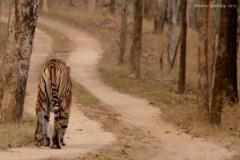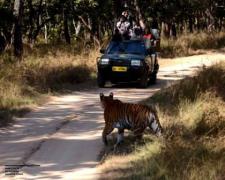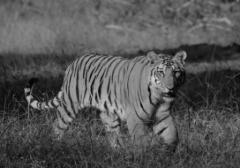At Kanha you can sight more mammals since the hard ground swamp deer and bison is found in greater abundance. Nevertheless the beauty of Bandhavgarh hillocks and glens is as enticing as that of grasslands of Kanha.I have been to Pench and seen fabulous tigers but the destination has less cross roads hence you see comparatively less of the cross section of the habitat. Nevertheless “The Spy in The Jungle” says it all about the Mowgli Land. Pench is also known as the Kipling Country since the “Jungle Book” is based on the forest of Seoni. To reach you can fly down to Nagpur and taxi eighty kilometers to the park. 


At Corbett the focus is on birds but it is a fantastic destination. It’s Terai landscape is mind boggling and mesmerizes you. The tiger reserve has many more mammals and you can see the yellow throated marten, hog deer and goral mountain goat. The sight of crocodiles and gharial is awe inspiring.
Ranthambhore has a good record of tiger sighting. It is in the Golden Triangle Tourism and provides easy accessibility from New Delhi. It takes about six hours to reach Ranthambore using train or taxi. Corbett takes about seven to eight hours by road and is overnight to Ramnagar by rail.
To reach Kanha you can fly to Jabalpur and drive three hours to the hotels. For Bandhavgarh you can fly to Jabalpur and drive four hours to Tala hotel complex. For both the destinations you can catch overnight rails to Jabalpur. For Bandhavgarh you can catch an overnight train from New Delhi to reach Umaria rail head which is 32 km from the park. A seven hours drive takes you to the park from Khajuraho Temples.
I have not been to Tadoba in Maharashtra but this place is abuzz with frequent tiger sightings. Though devoid of good accommodation there is a wild rush to get here and see the big cat. You can fly to Nagpur from New Delhi and then drive in a radius of hundred plus kilometers to reach the respective gate here. Book your accommodation in advance.
I may be biased in favor of Kanha and Bandhavgarh but for those focused on holistic experience should arrive at the former. While those looking for the exotic and intrigue should experience the ancient structures besides the tiger at the latter. That also means booking your safari and hotel much before your tour begins. These places offer experience of wild expanse of Indian jungle besides some amazing settings. At the world famous Bandhavgarh National Park tigers abound.
Of tiger safaris I should say sometimes you are unable to see the big cat hence always seek a holistic tour. It is essential not to rush, if hard pressed at least stay for two nights, three nights being ideal. Stay in an accommodation that is suitable for wildlife holiday. They should have good naturalists, interpretation center and serene ambiance.
Big cats are elusive but worth an effort to witness nature’s amazing charisma.
